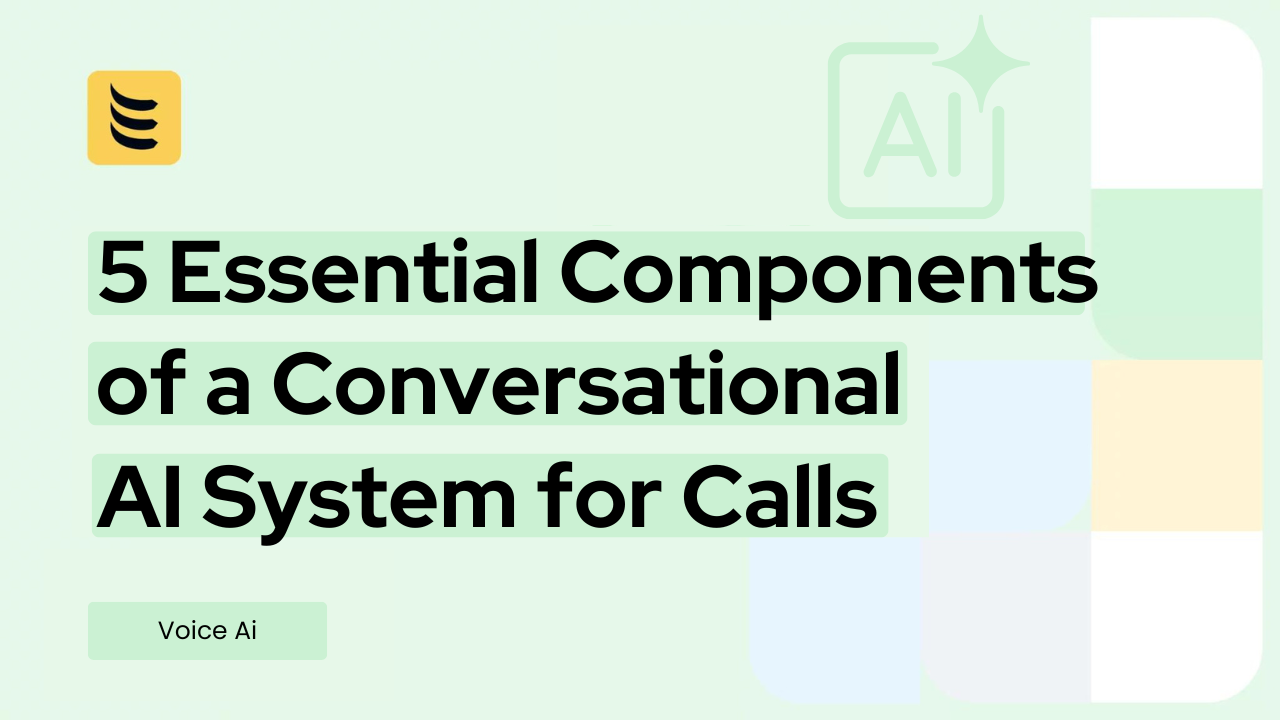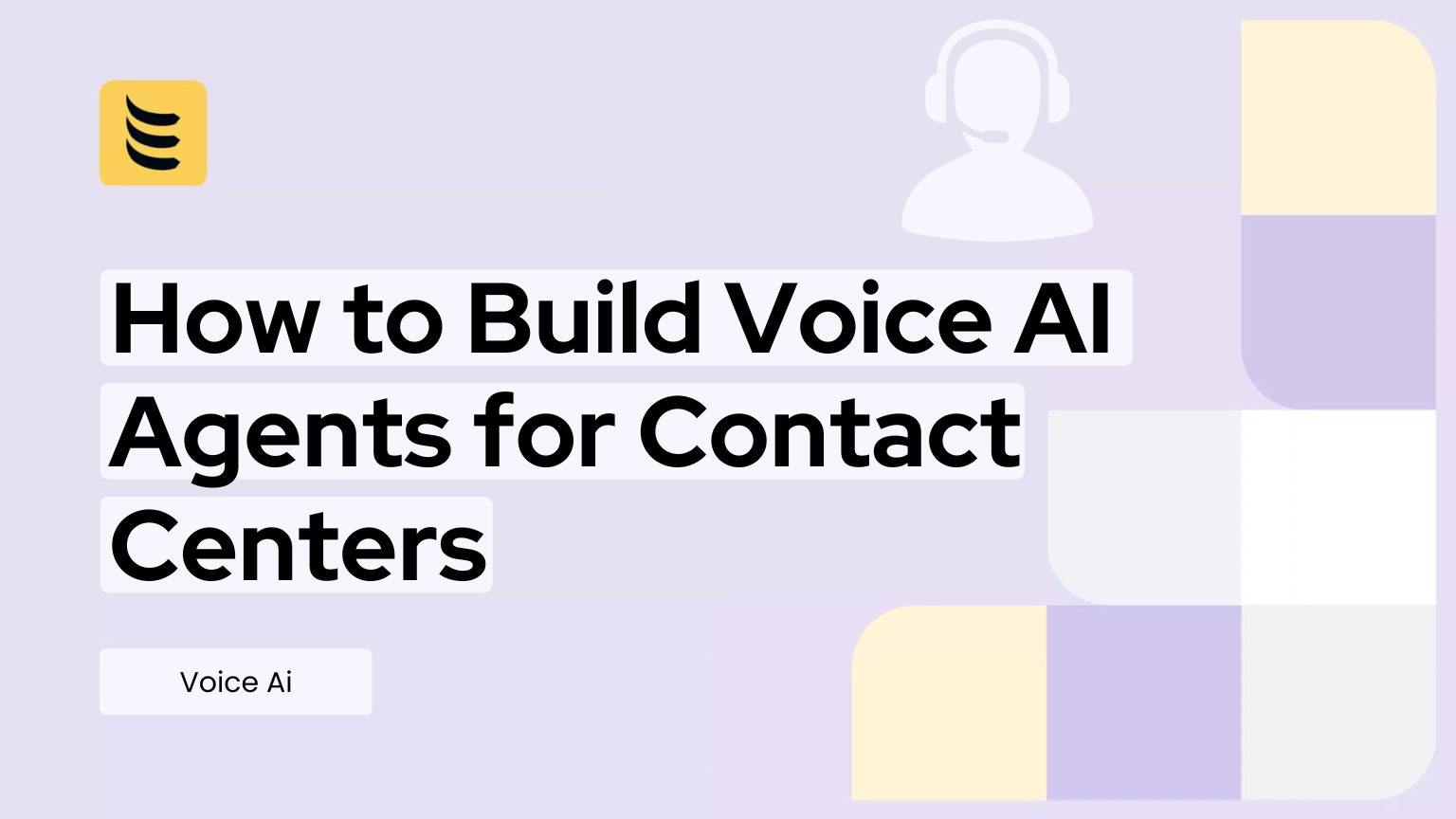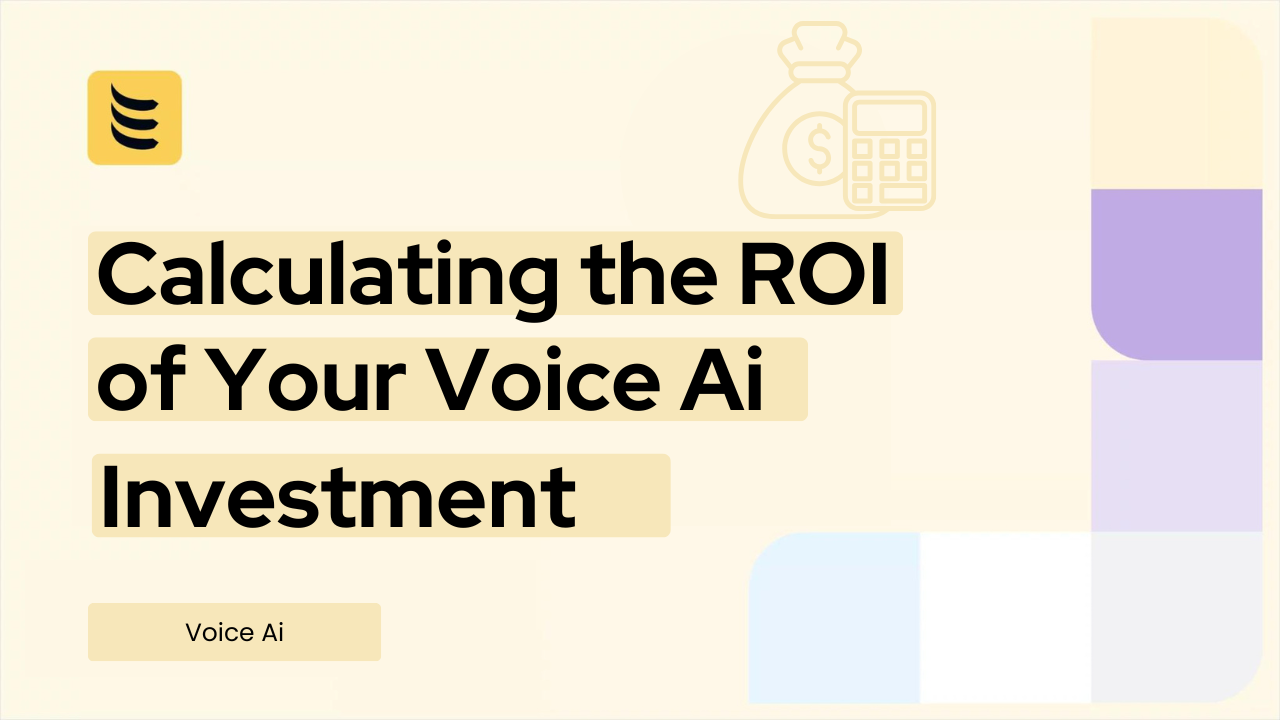Introduction
The sound of a busy signal or an endless hold loop is the sound of customer dissatisfaction and lost revenue. With customer call volumes soaring, and expected to reach an 80% automation rate for common service issues by 2029, businesses are at a crossroads. Relying solely on human agents for every inquiry is no longer scalable, leading to long wait times (over 60% of customers abandon a call if wait times exceed two minutes) and agent burnout. The mandate is clear: scale support, cut costs, and improve the customer experience—all at the same time. The solution is no longer basic automation; it is real-time, human-like voice AI.
Conversational AI for voice calls is fundamentally different and far more complex than the typical web chatbot. While a chatbot deals with clean, structured text, a voice agent must navigate the messy reality of the telephone:
Spoken Language: It must handle real-world acoustic challenges like background noise, overlapping speech, and diverse accents.
Real-Time Latency: It must process speech, understand the intent, formulate a response, and speak it back, all in the span of milliseconds, to maintain a fluid, human-like conversation pace. This is the difference between a frustrating IVR system and a genuinely helpful virtual agent.
A successful voice AI system that can operate at human-level proficiency in a live call environment is not a single piece of software; it is a meticulously engineered, real-time pipeline. To build a robust voice agent that can accurately understand, intelligently respond, and effectively resolve customer issues, you must master the five essential components that form its foundational architecture.
Over the next sections, we will break down the crucial role of each element in the voice AI pipeline:
Automatic Speech Recognition (ASR): The system’s “Ears.”
Natural Language Understanding (NLU): The system’s “Comprehension Brain.”
Dialogue Management (DM): The system’s “Flow Director.”
LLM and Business Logic: The system’s “Action Executor.”
Text-to-Speech (TTS): The system’s “Voice.”
Component 1: Automatic Speech Recognition (ASR)
A. The “Ears” of the System: Turning Sound into Sense
Before an AI can understand a single word, it first has to hear it. That’s the job of Automatic Speech Recognition (ASR). Think of ASR as the system’s pair of ears, but equipped with a superhuman transcription ability. Its core function is to take the raw, messy audio signal from the phone line, the waveform of a customer’s voice, and convert it into a clean, digital stream of written text.
This transcription is the single most critical handoff in the entire conversational pipeline. Why? Because if the ASR gets the words wrong, everything that follows—the understanding, the logic, the response, is flawed from the start. Garbage in, garbage out, as the old saying goes.
B. Navigating the Real-World Chaos of Voice Calls
While ASR has gotten incredibly good, transcribing a voice call is a tougher challenge than, say, dictating an email in a quiet room. The voice call environment is a minefield of potential errors:
Background Noise: The customer might be calling from a bustling train station, a busy office, or a home with children shouting or a TV blaring. The ASR has to intelligently filter out the noise and isolate the caller’s voice.
Accents and Dialects: Customers don’t speak like a unified textbook. A conversational AI must be trained on diverse datasets to accurately handle a broad range of regional accents, speech patterns, and even industry-specific jargon without missing a beat.
Real-time Streaming & Latency: This is where the “voice” challenge truly bites. The ASR can’t wait for the customer to finish their entire paragraph before spitting out the text. It must process the speech in real-time (streaming) to feed the rest of the system instantly. Any noticeable delay creates that frustrating, awkward pause that makes the AI sound slow and utterly robotic.
C. Why ASR Accuracy is Absolutely Essential
In short: the entire conversation hinges on ASR accuracy.
A chatbot can ask for clarification if a user misspells a word. A voice agent doesn’t have that luxury without sounding incredibly frustrating. If a caller says, “I need to check my account balance,” and the ASR hears, “I need to change my cat’s plans,” the NLU will route the call to an entirely wrong (and useless) path. Every subsequent component, the NLU, the Dialogue Manager, the Business Logic, is powerless if the initial transcription is wrong. Investing in high-accuracy, low-latency ASR technology is the first, non-negotiable step toward building a truly human-like and effective voice AI agent.
Component 2: Natural Language Understanding (NLU)
A. The “Comprehension Brain”: Figuring Out the Why
Once the ASR delivers the transcription, say, the text “I need to pay my internet bill with my Visa card that expires next month”, the Natural Language Understanding (NLU) component takes over. If ASR is the system’s ears, NLU is its comprehension brain. Its job is to move beyond the literal words and decode the intent and the specific data points the customer is providing. It’s about answering two crucial questions:
What does the customer want to do? (Intent)
What are the key details they are giving me? (Entities)
B. Decoding Intent and Extracting Entities
NLU uses machine learning models to perform this sophisticated linguistic analysis:
Intent Recognition: This is the most important step. The NLU analyzes the sentence structure and vocabulary to classify the customer’s goal. In our example, the intent would be Process_Payment. This immediately tells the system where to direct the conversation flow.
Entity Extraction: Once the intent is identified, the NLU scours the text to pull out the critical, reusable pieces of information—the entities.
Bill_Type: internet
Payment_Method: Visa card
Date_Reference: next month
Action: pay
This process effectively translates messy human language into clean, structured data that the rest of the AI can use to perform a task.
C. The Nuance Layer: Sentiment and Context
Top-tier voice AI systems push NLU beyond just intents and entities to understand the tone and urgency:
Sentiment Analysis: Is the customer frustrated or calm? If the NLU detects a sharp spike in negative sentiment (perhaps the ASR also picked up a raised voice), the system knows to bypass the usual script and potentially escalate the call to a human agent immediately, or at least use more empathetic language.
Context Management: If the customer had previously said, “I hate this late fee,” the NLU helps the system understand that a subsequent, unspecific utterance like, “Fix it,” still refers to the Late_Fee.
The accuracy of NLU is what truly distinguishes a clumsy, frustrating bot from a smooth, intelligent virtual assistant. If this stage fails, the agent may ask for information the user already provided or completely misinterpret the required action, leading to a breakdown in trust and efficiency.
Component 3: Dialogue Management (DM)
A. The “Flow Director”: Managing the Conversation State
If you’ve ever called an automated system and had to repeat your account number three times, you’ve experienced the failure of Dialogue Management (DM). DM is the heart of the voice AI’s intelligence. It’s the component responsible for managing the entire back-and-forth flow, ensuring the conversation is logical, context-aware, and—crucially—goal-oriented.
Think of it this way: DM maintains the “conversation state.” It’s a dedicated memory bank that tracks every piece of information collected, the current goal of the call, and what the system needs to say or ask next to move closer to a resolution.
B. Core Responsibilities that Define Human-Like Flow
DM is what elevates a simple script to a dynamic conversation:
- 1. Context Tracking (The Memory): When a user asks, “What’s my balance?” and the system provides the number, the conversation doesn’t end. If the user immediately follows up with, “And what about my last payment?“, without mentioning the account number again, the DM must remember the account_ID from the first turn. This ability to maintain context over multiple turns is the single greatest factor in making the AI feel natural and efficient.
- 2. Slot Filling and Logic: The DM identifies the information (the “slots” or entities) required to fulfill the user’s main intent. If the customer wants to book a flight (Intent: Book_Flight), the DM knows it needs three slots: Destination, Date, and Number_of_Passengers. It then strategically asks clarifying questions until all slots are filled, like a helpful travel agent walking you through a booking process.
- 3. Error and Interruption Handling (Grace Under Pressure): This is the ultimate test. What happens when the user interrupts the agent mid-sentence (the “barge-in” moment)? Or if the NLU is uncertain about the intent? The DM must have robust fallback and recovery policies. Instead of just saying, “Sorry, I didn’t get that,” a good DM system might confirm: “I heard you mention a late fee. Is that what you’re calling about?” It prevents the conversation from stalling or cycling into frustration.
C. The Difference Between a Robot and an Agent
Without a sophisticated DM, an AI is rigid; it forces the user down a predefined path. A human-written conversation, driven by strong DM, is flexible. It adapts when the user:
- Gives information out of order.
- Changes their mind mid-request.
- Digresses briefly before coming back to the main point.
The DM ensures the voice agent is a polite, focused director, guiding the user to their resolution efficiently, without demanding they conform to the machine’s limitations.
Component 4: Large Language Model (LLM) and Business Logic Integration
A. The “Action Executor”: Intelligence Meets Real-World Systems
This component represents the dual brain of the voice AI. It’s where raw understanding (from NLU and DM) is converted into intelligent action and customized replies. We can split its function into two tightly integrated parts: the modern intelligence layer (LLM) and the practical execution layer (Business Logic).
- The LLM (or NLG Layer): While traditional systems rely on template-based responses (Natural Language Generation – NLG), modern voice AI leverages Large Language Models (LLMs). The LLM takes the structured output from the Dialogue Manager (e.g., Intent: Process_Payment, need to ask for CVV) and crafts a natural, human-sounding text response. It ensures the reply is contextually appropriate, grammatically perfect, and maintains the established tone. It’s the part that ensures the AI doesn’t just say, “Need CVV now,” but rather, “Great. To finalize that payment, could you please tell me the three-digit security code on the back of your Visa card?”
B. The Business Logic: Connecting to the Real World
This is the vital bridge between the AI’s “thought process” and the company’s real-world infrastructure. An AI that can talk but can’t act is useless.
When the Dialogue Manager decides an action is necessary—like checking an account balance, booking an appointment, or resetting a password—the Business Logic layer:
- 1. Formulates the API Call: It takes the entities extracted by the NLU (e.g., account number, last four digits of social) and structures them into a secure, executable request.
- 2. Integrates with Backend Systems: It makes the call to your CRM (like Salesforce), your ticketing system, your database, or your proprietary banking software.
- 3. Processes the Result: It receives the data back (e.g., the account balance is $450.12) and hands it back to the LLM/NLG to generate the final spoken reply.
C. The Importance of Secure and Accurate Integration
This component is the gatekeeper of your customer data and services. If the Business Logic is faulty, the AI might process a transaction incorrectly or access the wrong customer record. A truly human-like voice agent needs to be a powerful and reliable digital employee, not just a conversational toy. The quality of this integration dictates the AI’s ability to achieve First Call Resolution (FCR), the ultimate metric for any contact center.
Component 5: Text-to-Speech (TTS) and Voice Interface
A. The “Voice” of the System: Making Text Sound Human
The final component in the voice AI pipeline is Text-to-Speech (TTS). This module takes the beautifully crafted textual response from the LLM/NLG (e.g., “Your new account balance is four hundred fifty dollars and twelve cents.”) and transforms it back into a natural, spoken audio stream.
TTS is where technology meets human psychology. The quality of the synthetic voice is often the single biggest factor determining whether a customer views the interaction as convenient and modern or frustrating and outdated. Modern TTS engines use advanced neural networks to go far beyond the monotone, robotic voices of the past. They can now incorporate:
- Human-like Intonation and Stress: Raising the pitch on questions and emphasizing key words (like “new balance”) to convey meaning naturally.
- Emotional Range: Adjusting the tone to sound empathetic during a complaint or authoritative when reading a security confirmation.
B. Voice Interface Design: Beyond Just Speaking
Building a great voice agent requires more than just high-fidelity audio; it requires conscious Voice Interface (VUI) Design. This focuses on the practical real-time interactions that define a comfortable call experience:
- The Persona is the Brand: Every brand must select or even custom-clone a voice that aligns with its personality, whether it’s warm and friendly for customer support, or crisp and professional for financial services. The voice is the sonic representation of your brand.
- Zero-Tolerance for Latency: In voice calls, the time between the customer finishing their sentence and the AI starting to reply (Time-to-First-Audio) must be minimal, ideally under 300 milliseconds. If the AI hesitates, even for half a second, the customer perceives it as slow, inefficient, or broken, leading them to interrupt or hang up.
- Handling the Barge-In: A truly human conversation allows for interruption. The VUI must be sophisticated enough to allow the customer to “barge in” (speak while the AI is talking) and have the ASR recognize the interruption instantly, cutting off the TTS playback and transitioning smoothly to the NLU phase again. This is a non-negotiable feature for real-time voice realism.
C. The Grand Finale: Why TTS is the User’s Reality
The entire, complex architecture, the ASR, NLU, DM, and LLM, is invisible to the customer. All they perceive is the voice that responds to them. If the voice is warm, responsive, and articulate, the complex system is validated. If the voice is choppy, delayed, or poorly inflected, the entire multi-million dollar AI investment feels cheap. TTS is the final mile, the point where all the intelligence and logic are delivered, determining the customer’s satisfaction and the agent’s success.
Conclusion: A Seamless Conversation Pipeline
The journey from a customer’s spoken word to a successful, automated resolution is a demanding one. As we’ve seen, the true power of Conversational AI isn’t in any single tool, but in the seamless, real-time collaboration of these five core components:
- ASR (The Ears): Accurately capturing the human voice amidst noise and accents.
- NLU (The Comprehension Brain): Decoding the intent and extracting critical data points.
- DM (The Flow Director): Managing context and guiding the multi-turn dialogue logically.
- LLM & Business Logic (The Action Executor): Generating human-like replies and securely integrating with backend systems to perform real tasks.
- TTS (The Voice): Delivering the final message with natural-sounding intonation and zero latency.
When integrated perfectly, this pipeline stops being a collection of technologies and becomes what every business needs: a hard-working, intelligent digital employee capable of handling soaring call volumes, drastically reducing operational costs, and, most importantly, delivering a consistently excellent customer experience, 24 hours a day.
Ready to Launch Your Next-Gen Voice Agent?
You understand the components. Now, you need the platform built to deliver them flawlessly.
If your business is ready to move past frustrating IVR trees and deploy a truly intelligent voice solution, IDT Express offers a Voice AI platform designed for performance and scale. We combine state-of-the-art ASR/NLU for unparalleled accuracy with native telephony integration, ensuring ultra-low latency and crystal-clear call quality, the absolute foundation for human-like conversations.
Stop managing separate vendors for every piece of the pipeline. Leverage the one platform that provides the architecture, the quality, and the global network you need.
Request a Demo of the IDT Express Voice AI Agent Platform Today.
See how fast and effectively our business-ready AI can start resolving your customer inquiries and delivering measurable ROI in weeks, not months.



